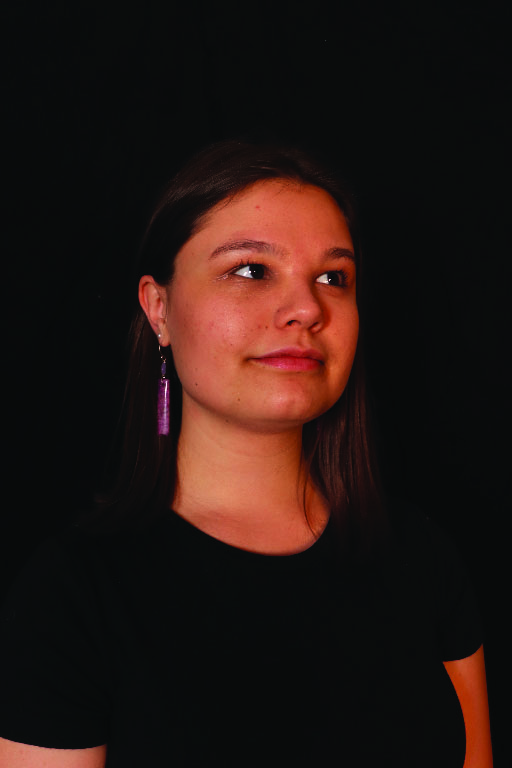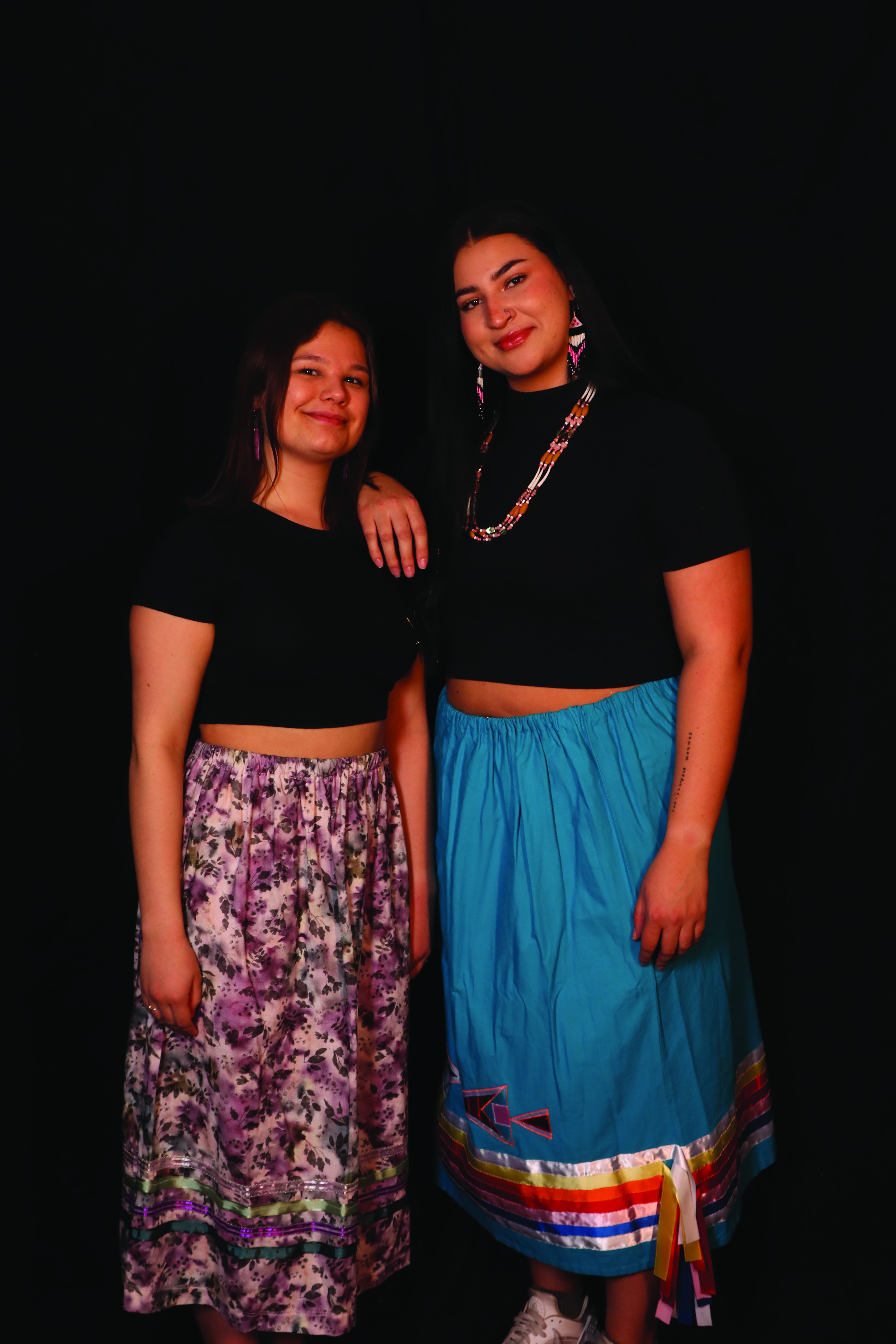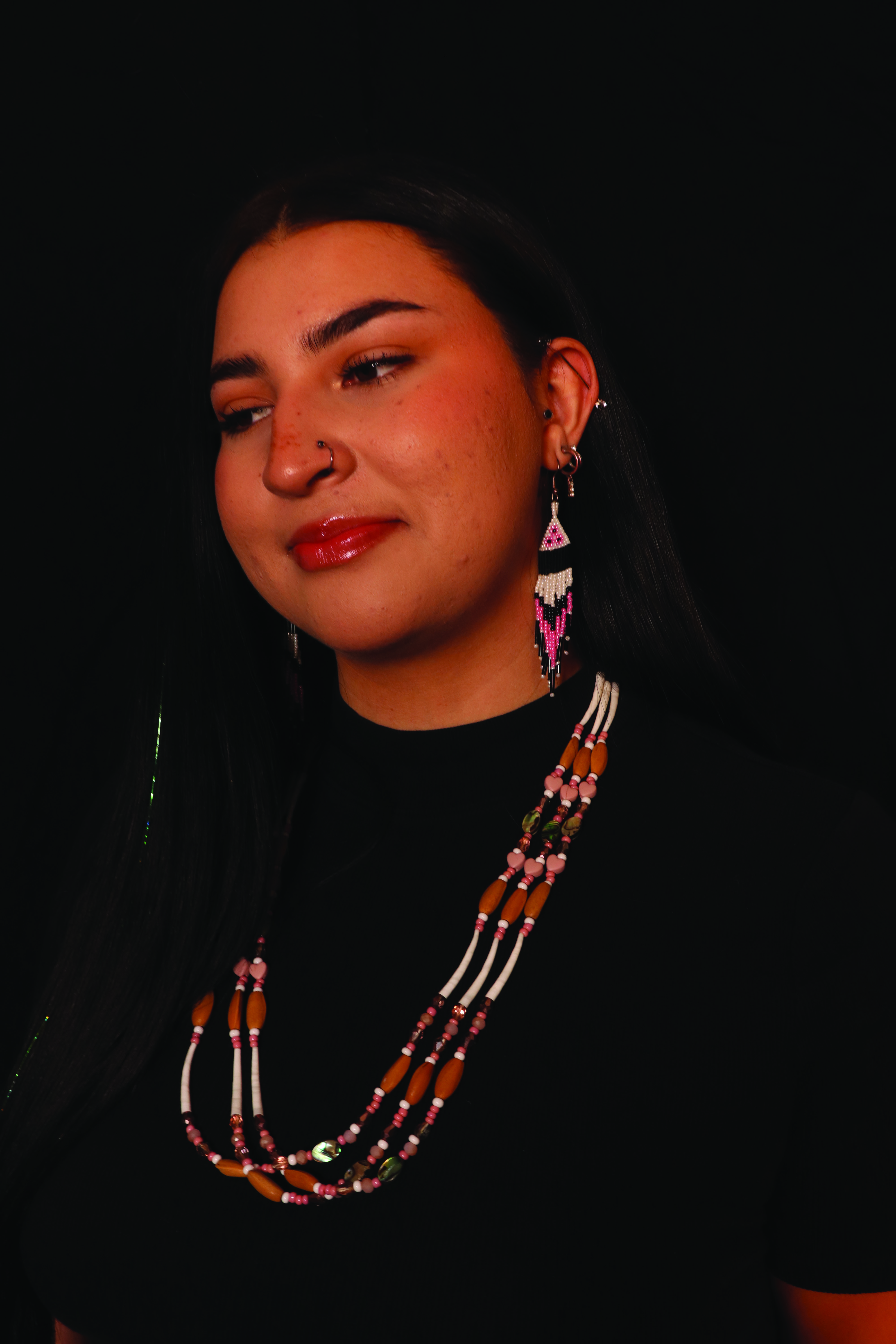SESP second-year Alivia Britton, a member of the Little River Band of Ottawa Indians, was up and running at 8:00 a.m. on a Saturday. It was the morning of Northwestern’s first Pow Wow, and she and the Pow Wow planning committee had been organizing the event for months. But as their noon start time approached, the only students she saw in attendance were her friends. Northwestern’s undergraduate population hadn’t shown up like she thought it would.
“I was like, ‘Oh my gosh, everyone’s going to come, this is so cool.’ Why wouldn’t people come?” Britton says. “That was really hard for me to process.”
When NAISA, Northwestern’s Native American and Indigenous Student Alliance, put on their first Pow Wow last spring, over 500 attendees danced, ate and mingled in Welsh-Ryan Arena. But at a school with over 8,000 undergraduates, students in NAISA are dreaming bigger for the upcoming event on April 22. This year’s Pow Wow planning co-chairs, Britton and Communications second-year Mel McDaniel, hope to turn the event into a hallmark tradition for Northwestern’s Native community.
Pow Wows provide a chance for Native students to celebrate their Indigeneity and for all students at Northwestern to eat, dance and learn more about Native cultures. Schools such as Brown, Dartmouth, Stanford and University of Illinois Chicago already have annual Pow Wows. But Aaron Golding, NAISA Advisor and Multicultural Student Affairs Associate Director, says Northwestern’s Native population hadn’t been large enough to pull one off until last spring. NAISA has about 10 members this year, and Golding says he’s seen the club triple in size since he started as an advisor four and a half years ago.
Last year’s NAISA co-chair Isabel St. Arnold (SESP ’22), who is Keweenaw Bay Ojibwe, dreamt of putting on a Pow Wow. In her final year at Northwestern, she asked Britton and McDaniel, both freshmen at the time, to help her pull it off.
McDaniel, who is Tyme Maidu of Berry Creek Rancheria of Oroville, California, says 500 people was a good start for the University’s first-ever Pow Wow. But she knows they can do better. McDaniel and Britton lead the Pow Wow planning committee with three faculty advisers, and everything is a team effort. McDaniel says both her and Britton are perfectionists, and they’re going all out to make the event major.
“We want more,” Britton says. “We’re capable of more.”

Britton got her earrings last year at the sixth annual Chicago American Indian Community Collaborative (CAICC) Urban Native Education Conference. A local Indigenous artist made them. (Photo by Eloise Apple)
Filling Welsh-Ryan
Planning a Pow Wow isn’t easy.
Senior Assistant Director for Undergraduate Admissions and Pow Wow planning committee member Niyo Moraza-Keeswood, who is Navajo and Chichimeca, has planned Pow Wows at his alma mater, Brown University, for seven years and danced in Pow Wows since he was young. He says the biggest hurdle is finances, which involve explaining what a Pow Wow is to different offices at Northwestern, asking for funding, paying for a venue and providing hired singers, dancers and staff with any necessary accommodations.
From there, planners have to think about who’s going to run the event. Every Pow Wow has some staple roles, Moraza-Keeswood says. First, there’s an emcee, the person with the knowledge and protocol of how a Pow Wow is run. The emcee teaches the attendees what certain dances are, what the background is and when people should and shouldn’t be recording.
Next, there’s an arena director who manages logistics and helps the emcee lead the event. The arena director makes sure the dancers are taken care of and that the area where people are dancing is properly respected.
Then there are head dancers, who lead tribal and intertribal dances. There are also teams in charge of advertising and outreach to bring in singers, drum groups, vendors and food. And to top it all off, Pow Wow planners have to coordinate with athletics and facilities and get the word out to the local community.
“It’s a lot,” Moraza-Keeswood says. “It’s a months-long process. And it’s a lot of relationship building that’s really essential in pulling off a Pow Wow.” Despite the massive task at hand, Moraza-Keeswood says McDaniel and Britton have filled their roles with determination and grace.
“When I started organizing Pow Wows, it was a very chaotic process. We had an idea of what we were doing, but we were not necessarily as organized as they were,” Moraza-Keeswood says. “I’ll give them their flowers because it’s well deserved.”
A driven duo

Caption goes here. (Photo by Eloise Apple)
Britton and McDaniel juggle Pow Wow planning meetings with pre-planning meetings, general NAISA meetings and NAISA council meetings each week, in addition to a full course load and numerous other extracurricular activities.
Outside of the Pow Wow, McDaniel is a research assistant at a campus lab where she helps children who have bilateral sensorineural hearing loss with their language development. Britton works at the Learning Bridge Early Education Center and helps lead Alternative Spring Break, a program for Northwestern students centered around social justice in Chicago. The two make a powerful team.
In preparation for this spring’s Pow Wow, McDaniel and Britton hit the ground running. They began planning in October, three months earlier than NAISA started last year, and they’re expecting to raise $36,300, tripling last year’s $12,000.
While McDaniel leads the creative side — sketching designs and planning visuals — she says Britton has impressive administrative skills and efficiently manages student finance and email outreach. The two met last year in NAISA but say they’ve grown much closer through their collaboration.
“We were the perfect people to be picked to work together,” McDaniel says. “I love everybody in NAISA, but if I think about me working on the Pow Wow being paired with anyone else as a co-chair, it probably wouldn’t have worked [as well].”
McDaniel and Britton say they’re a strong partnership because they’re both driven, hard working and know when to lean on each other for help. They also live near each other and love grabbing meals together and venting when they need to.
“We know each other pretty well and we know each other’s limitations. If we’re stressed, we can rant to each other. We’re just really close,” Britton says.
“And complainers,” McDaniel adds jokingly.
The two want to make the next Pow Wow bigger. They want to bring in famous dance groups, more food, vendors, merch and housing accommodations for everyone involved. They hope to get professional signage they can use every year, instead of the handmade marker-written signs they used last year.
McDaniel also says she hopes to step up the Pow Wow’s marketing efforts. Last year, they had advertisements on TVs across campus, posters, banners at the Multicultural Center and the Center for Native American and Indigenous Research, along with social media posts and Chicago Public Schools newsletter blurbs. Their efforts this year will include sending out big email chains to reach the older Native community, and they hope to bring little “save-the-date” papers to other Native conferences they attend this year.
McDaniel says the two have been convening weekly for nearly a year to make things happen. At each meeting, she and Britton keep track of outreach to dancers, drummers and head staff, as well as grant deadlines and fundraising efforts.
“We’ve put in so much work for this. I’m always thinking about this Pow Wow. It’s always in the back of my mind like ‘Oh I’ve got to do this, and I’ve got to do this,’” Britton says. Though it is a large task, Britton says it’s something they’re both glad to take on. “It’s also such a blessing that we’re able to do this, and I just feel really grateful that I’m in a space where I can plan an event like this and get the money to put something on,” she says. “We’ve just put in so much work, I want something to come with it.”
The power of the Pow Wow
For McDaniel, planning a Pow Wow is like bringing a piece of home to Northwestern. Growing up near her tribal reservation in Nevada, McDaniel participated in games, celebrations and ceremonies. She remembers learning songs to sing while playing hand games with other kids at Pow Wows. But when she moved to New Mexico when she was eight, she felt she missed a lot of formative experiences, including learning her Native language and how to dance.

McDaniel got her earrings from a basket weaving convention back home and the necklace is her graduation beads, a gift from her tribe when she graduated high school. (Photo by Eloise Apple)
Now that she’s at Northwestern, McDaniel doesn’t get to go home often. When she lived in New Mexico, she would drive back near her reservation every summer and winter to pick willow and gather materials to weave baskets. But now, McDaniel’s mother often makes the trip alone. “I don’t get to participate in a lot of the things that are meaningful to me, so when we bring that here, it feels like I have a part of my home and my childhood,” McDaniel says. “I have my family both from California and Nevada coming in for the Pow Wow, so I also get to bring my home here.”
For Britton, planning this Pow Wow also means stepping into and celebrating her Indigenous identity, which she hadn’t been able to do as much before college. She was raised by her mother, who is white.
Britton says her memories of last year’s Pow Wow inspire the joyful atmosphere she hopes to recreate this year. She remembers everyone’s laughs and smiles, seeing Northwestern’s Native community and how proud everyone was.
“Thinking about how happy our community was last year at the Pow Wow, we just have to continue that,” Britton says. “If that’s one thing that I can ensure will happen on this one date every single year, I will do whatever I can just to see everyone’s smiles and to see all the generations come together.”
Jasmine Gurneau, Northwestern’s Director of Native American and Indigenous Affairs, says the Pow Wow opens up Northwestern’s campus to allow Native people into the space, not just as spectators but as the people actually dancing on the main floor. It’s a cultural celebration for both Natives and non-Natives to take part in.
Gurneau, who is a citizen of the Oneida Nation and a descendant of the Menominee, says she talked to a non-Native prospective student who was visiting Northwestern at last year’s Pow Wow. The student told her attending the Pow Wow made them want to apply to Northwestern, because it showed the University cares about and highlights their Native American community. “And that’s when I was like, ‘OK, wow,’” Gurneau says. “This is so much bigger than a Pow Wow.”
Northwestern’s Pow Wow opens up the school’s multi-million dollar arena to the greater Chicago area. Moraza-Keeswood says last year’s Pow Wow resulted in the most Native community members Northwestern has ever seen on campus at once.
The Chicago Native community is big, strong and diverse. While Illinois doesn’t have any federally recognized tribes, Chicago has the third-largest urban Native American population in the U.S., with over 65,000 Native Americans living in the greater metropolitan area and more than 175 tribes represented.
Britton says she hopes the Pow Wow will connect Northwestern with Chicago’s Native community and help bridge the gap between the University and the city at large.
“An institution like Northwestern can appear very colonizing and elitist, and at the end of the day, we’re just students, but we want to be in touch with the Native people whose land we’re on,” Britton says.
For McDaniel, watching other people step into their culture would make it all worth it. She says there are many other members of NAISA who feel a disconnect in their Native identities similar to herself, and the Pow Wow serves as a milestone event to celebrate their Indigeneity.
“We’ve got some shy people in NAISA. And seeing them dance, it looks like they feel at home,” McDaniel says.
The Pow Wow is McDaniel and Britton’s passion project. They hope Northwestern’s community will show up in ways they failed to last year and that this year’s celebration will cement the Pow Wow as an event to look forward to for years to come.
“Beyond the scope of the Native community, everybody can enjoy a Pow Wow,” McDaniel says. “Dance a little, get a little food.”
Non-Native students can join in during the intertribal dances, Britton says, and it’s always fun seeing everyone on the dance floor together.
McCormick second-year Camille Layden met Britton as a Peer Adviser last spring. She says Northwestern’s administration and students “talk a big game” with land acknowledgments and allyship dialogues, but feels it’s hypocritical when people don’t show up to events led by the school’s Indigenous community members.
“I see so many people with the stickers on their computers like ‘Council of Three Fires,’” Layden says. “But I’m like, ‘OK, put your money where your mouth is.’”
Layden, who is white, says she’s excited to attend this year’s Pow Wow and sees it as a special opportunity to be invited and welcomed into another community’s celebrations. Beyond acknowledgement, Layden says the Pow Wow is a great way to honor, experience and celebrate Native American history and culture.
McDaniel hopes to be involved with Pow Wow planning for the rest of her time at Northwestern and watch the event grow over time.
“We have to put in a lot of effort now so people will continue to do it. I don’t want us to do four years of Pow Wow and then it dies. That’s another reason why we’re trying to make it so big and exciting. We don’t want it to stop when we’re done doing it,” McDaniel says. “That would be brutal. I would cry. I would cry a lot.”
This burden can be a lot to carry. McDaniel says students often talk about wanting change, but ultimately it falls back on those students to create the systems for themselves and see them succeed. McDaniel says even if she and Britton don’t want to keep the Pow Wow planning role in the future, they need to create a binder and structure for it to continue. “So we’re doing it now,” McDaniel says. “Hopefully we’re inspiring other people to care later, so that it’s not all on us.”
For McDaniel and Britton, seeing the seats of Welsh-Ryan Arena filled with the faces of both loved ones and strangers would mean the world. It would mean all their hard work to build not just a landmark event, but a legacy, would have paid off.
“I’m thinking about our little freshman, one of our freshmen in NAISA right now,” Britton says. “I want to do it for her. I want to prove that this is something cool. It’s worth it.”